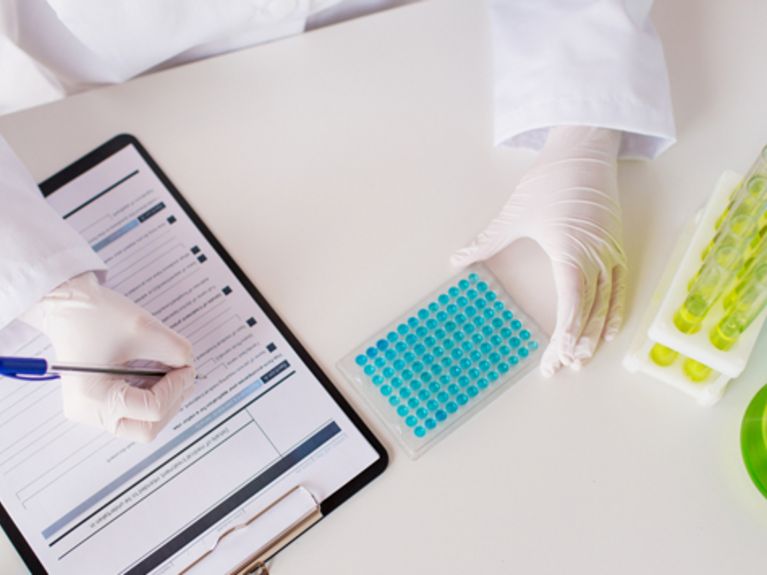Klinische Studien
Wenn Medikamente an Menschen getestet werden

Nahaufnahme von Wissenschaftler mit Testprobe im Labor. Bild: Syda Productions / shutterstock
Im Laufe der langjährigen Medikamenten-Entwicklung wird der Wirkstoff in klinischen Studien erstmals auch im Menschen eingesetzt. Wie funktionieren klinische Studien eigentlich – und wie sicher sind sie?
After a man died and five men became severely ill during a recent clinical study in France, uncertainty prevails. Kai Schmidt-Ott, Professor and research-group leader at the Max Delbrück Center for Molecular Medicine in the Helmholtz Association (MDC), speaks about the necessity and significance of drug tests on human beings and how safe they are.
Herr Schmidt-Ott, every medication has to be tested on human beings for the first time at a certain point during its development. Who volunteers for this and why?
First of all, it must be said that a multi-year period of medicine development precedes the first application of drugs in human beings. During this process a comprehensive examination is carried out on the one hand to check if the potential medication – when compared to comparable, previously-approved pharmaceuticals administered for the disease complex to be treated – really is better suited. On the other hand, the active substance is only used on human beings once optimal examinations have been carried out to determine if it really is safe. Only when both cases prove to be the case and it has been tested by an ethics commission and the respective supervisory authority – in Germany it is the Federal Institute for Drugs and Medical Devices (BfArM) or the Paul Ehrlich Institute (PEI) – the so-called clinical studies commence. This is where the drug is tested on human beings. These studies comprise four phases. Usually, the test subjects in Phase 1 are healthy volunteers. They frequently choose to be involved for the simple reason that there is financial compensation for it.
Why are healthy volunteers taken fist, instead of patients who are slated to be treated with this medication later on?
Because the main issue in the beginning is confirmation that this drug is fundamentally safe for human beings. If sick patients were tested right from the start, it would be difficult to separate the drug’s undesired effects from the already existing disease symptoms. Furthermore, healthy individuals have good liver and kidney function, which is important for decomposition and excretion of the medication. Even if unexpected effects appear, healthy test subjects would be able to compensate for this better.
You are saying that everything possible is done to make sure that the medication does not become dangerous to their health, and that it does not lead to unexpected effects. How can that be guaranteed?
Human metabolism has been very thoroughly researched over the years. For example, the effects and traces of pharmaceuticals in the candidates’ bodies can be calculated quite well on the basis of computer models. However, experiments with animals are even more important; before a drug is sent to the clinic, it is always tested first on animals. On the basis of studies that examine the drug’s toxicity and behaviour in the animal model, it can be estimated how the drug would possibly work in the human body. If there is no concern in this regard, the clinical Phase-1 study begins as a supplementary safety measure with administration of an especially low dosage.
How often do incidents occur?
As far as I know, in Germany a patient in a Phase-1 study has never died after taking an active substance. In the professional magazine British Medical Journal there was a meta-analysis involving Phase-1 studies with more than 10,000 patients. Even in this case there were no fatalities. The death of the test person in France is an absolute exception. Undesired effects can nevertheless appear sometimes. In 0.3 percent of the cases, severe complications can arise. In short this means - the whole process is quite safe, but there always exists a slight degree of risk in cases like this.
There are also a few drugs that have strong side effects such as chemotherapeutic substances for cancer therapy. Are these also being tested on healthy volunteers?
When considerable side effects can be sufficiently estimated medically, and the drug shows promise of a clear benefit, it does in fact sometimes happen that the phase requiring healthy test subjects is skipped. The potential drug is administered directly to those who are someday meant to be treated with it.
And what is the procedure when a drug is needed quickly against Ebola during a pandemic, for example? Does the test process on healthy test subjects take too much time?
The same basic principles are, as a rule, valid here. But of course, the respective officials offer accelerated approval procedures in exceptional cases that allow new drugs to be made quickly accessible to patients with severe or particularly rare diseases. By this means, provisional approval could be made possible prior to completion of the comprehensive clinical test.
You spoke about four clinical phases. How does the process continue after the first clinical phase in drug development?
In Phase 2 the doctors examine, on the basis of several hundred patients, whether the drug basically acts in the desired way. In Phase 3 the issue involves showing the preponderance of the drug’s advantages for several thousand patients. If all phases were successful, the drug can be approved. But even once it is on the market, the doctors continue to observe it, in Phase 4, for a period of time. This involves finding out if a drug has extremely rare side effects, which in some cases only appear later on and had not been discovered previously.
Readers comments